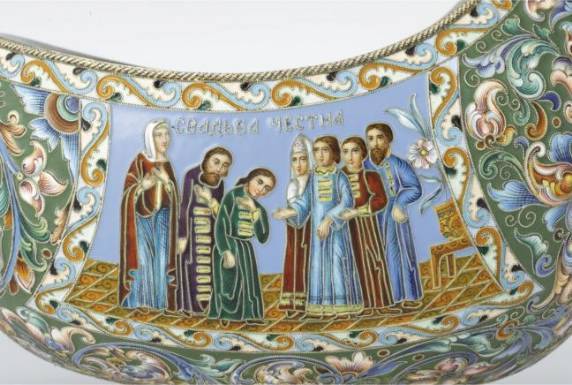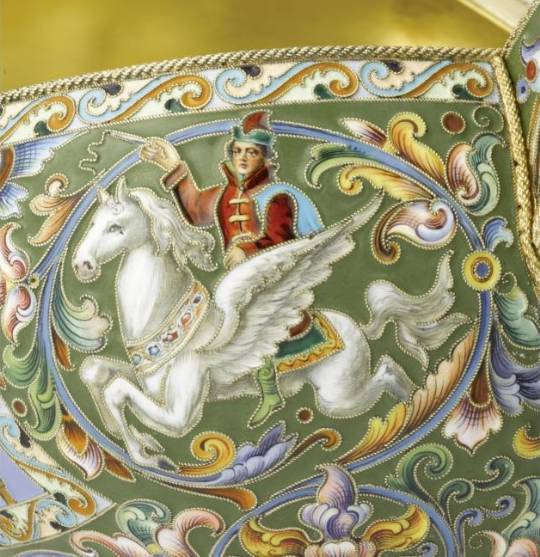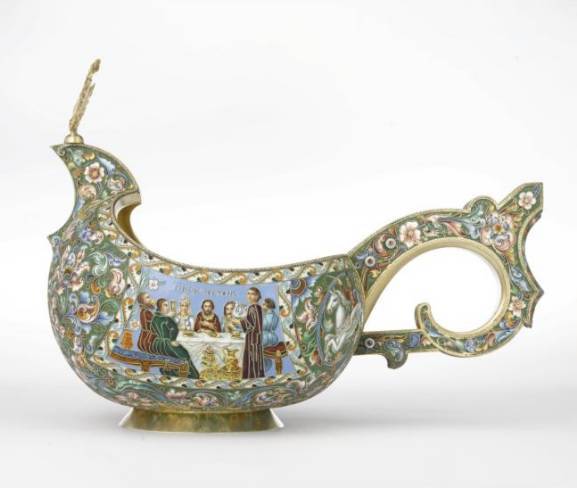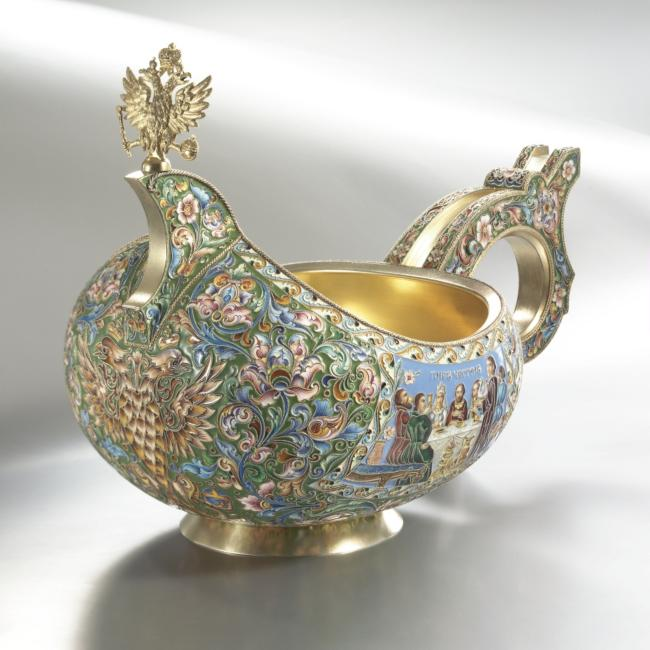Работы Рюккерта, проданные на аукционе Сотбис




IMPORTANT RUSSIAN ENAMELS AND FABERGE FROM A NEW YORK PRIVATE COLLECTION
Sale: N08718
Location: New York
04 Nov 2010
LOT 17
A FINE AND MASSIVE RUSSIAN GILDED SILVER AND SHADED ENAMEL LARGE WEDDING KOVSH, FEODOR RÜCKERT, RETAILED BY OVCHINNIKOV, MOSCOW, CIRCA 1900
200,000—300,000 USD
Location: New York
04 Nov 2010
LOT 17
A FINE AND MASSIVE RUSSIAN GILDED SILVER AND SHADED ENAMEL LARGE WEDDING KOVSH, FEODOR RÜCKERT, RETAILED BY OVCHINNIKOV, MOSCOW, CIRCA 1900
200,000—300,000 USD
Measurements
length 14 in.
Alternate measurements
35.6 cm
Description
length 14 in.
Alternate measurements
35.6 cm
Description
of typical form, with elaborately scrolled handle and pointed prow, decorated with scrolling shaded tulips and foliage outlined with applied filigree wires against a green ground, the handle also with applied enamel pellets in turquoise and iron red, incorporating at the front a Russian double-headed eagle and two flying horsemen in boyar costume at the back, the borders with multicolored scrolls in peach, tobacco, turquoise, and pale green; both sides with larger figurative panels: the first with the choosing of the bride against a sky blue ground and the second with a scene of the wedding feast, also with a sky blue ground, the prow set with a gilded, double-headed Imperial eagle, set on a ring foot
PROVENANCE
Sotheby's, Geneva, November 11, 1981, lot 421.
CATALOGUE NOTE
Sotheby's, Geneva, November 11, 1981, lot 421.
CATALOGUE NOTE
In this magnificent and rare kovsh, Feodor Rückert sums up the key elements of Russian traditional and contemporary art that were most sought after around the turn of the last century. Large panels on either side of the kovsh depict the selection of a bride in an old boyar household and the subsequent wedding feast of the young couple. The two images are clearly references to a series of popular paintings by Konstantin Makovsky (1839-1915) completed in the 1880s. The first was A Boyar Wedding Feast of the 17th Century (Hillwood Museum & Gardens, Washington, DC), a monumental canvas painted in 1883 and subsequently exhibited in St. Petersburg, Moscow, Paris, London and in Amsterdam at the 1885 International exposition, where the painter was awarded a Gold Medal. The richly detailed clothing and the closely observed period objects that filled the canvas made this one of the most enduringly popular Russian paintings. Even after it was purchased by American jewelry entrepreneur Charles Schumann (1845-1912) in 1885, numerous copies of it decorated everything from Rückert's enamels to the covers of gift boxes of chocolate. Schumann installed the painting in his jewelry shop in New York where it attracted so much attention and business that in 1886 he commissioned a second painting, The Choosing of A Bride (by Tsar Aleksey Mikhailovich), now in the collection of the Museo de Arte de Ponce, Puerto Rico. Before delivering it to its American owner in 1887, Makovsky exhibited the painting at a bank on St. Petersburg's Nevsky Prospekt, assuring that it was as well known as A Boyar Wedding Feast of the 17th Century. It is no surprise that, as the offered lot demonstrates, the two paintings were thought of as a series even if one work depicts a specific historical event and the other a generalized scene illustrating no particular family. On the sides of the kovsh, Makovsky has simplified and rearranged the compositions to bring focus on the key participants in what the applied cable ornament identifies as an "Honorable Wedding" and an "Honorable Feast." The remainder of the body is decorated with ornament inspired by 17th-century enamels such as the stylized tulips and scrolling foliage familiar from Usolsk enamels as well as a double-headed eagle without the triple crowns, orb or scepter. According to family tradition of the owner who sold the kovsh in 1981, Emperor Nicholas II presented it to a family member who was a high-ranking French cavalry officer during the Imperial couple's 1896 visit celebrating the Franco-Russian alliance and the laying of the cornerstone of the Pont Alexandre III. Family tradition records that the kovsh was the trophy for a race held October 7, 1896, the day on which the Imperial couple laid the bridge's cornerstone, but the official schedule includes no information on a race. It is more likely to have been given as a gift to one of the Parisian dignitaries of the French
Republic. For more information on Makovsky's boyar and historicist works, see E.V. Nesterova, Konstantin Egorovich Makovskii, St. Petersburg, 2003, 73-75, 91-92.
